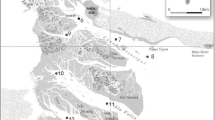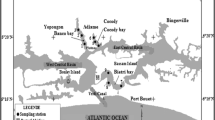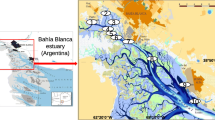Abstract
The dissolved labile and labile particulate fractions (LPF) of Cu and Zn were analyzed during different seasons and salinity conditions in estuarine waters of marina, port, and shipyard areas in the southern region of the Patos Lagoon (RS, Brazil). The dissolved labile concentration was determined using the diffusive gradients in thin films technique (DGT). DGT devices were deployed in seven locations of the estuary for 72 h and the physicochemical parameters were also measured. The LPF of Cu and Zn was determined by daily filtering of water samples. Seasonal variation of DGT–Cu concentrations was only significant (p < 0.05) at one shipyard area, while DGT–Zn was significant (p < 0.05) in every locations. The LPF of Cu and Zn concentrations demonstrated seasonal and spatial variability in all locations, mainly at shipyard areas during high salinity conditions. In general, except the control location, the sampling locations showed mean variations of 0.11–0.45 μg L−1 for DGT–Cu, 0.89–9.96 μg L−1 for DGT–Zn, 0.65–3.69 μg g−1 for LPF–Cu, and 1.35–10.87 μg g−1 for LPF–Zn. Shipyard areas demonstrated the most expressive values of labile Cu and Zn in both fractions. Strong relationship between DGT–Zn and LPF–Zn was found suggesting that the DGT–Zn fraction originates from the suspended particulate matter. Water salinity and suspended particulate matter content indicated their importance for the control of the labile concentrations of Cu and Zn in the water column. These parameters must be taken into consideration for comparison among labile metals in estuaries.





Similar content being viewed by others
References
Abbot, A., Abel, P. D., Arnold, D. W., & Milne, A. (2000). Cost-benefit analysis of the use of TBT: the case for a treatment approach. Science of the Total Environmental, 258, 5–19.
Alzieu, C. L. (2000). Environmental impact of TBT: the French experience. Science of the Total Environmental, 258, 99–102.
Baisch, P. R., & Wasserman, J. C. (1998). Chemistry and distribution of elements in the Patos Lagoon. In J. C. Wasserman, E. Silva-Filho, & R. Villa-Boas (Eds.), Environmental geochemistry in the tropics (pp. 97–126). New York: Springer.
Baraj, B., Niencheski, L. F., & Corradi, C. E. (2003). Trace metal content trends of mussel Perna perna (Linnaeus, 1758) from the Atlantic Coast of Southern Brazil. Water, Air, and Soil Pollution, 145, 205–214.
Brooks, S. J., & Waldock, M. (2009). Copper biocides in the marine environment. In T. Arai, H. Harino, M. Ohji & W. J. Langston (Eds.), Ecotoxicology of antifouling biocides. Springer: New York
Chiffoleau, J. F., Cossa, D., Auger, D., & Truquet, I. (1994). Trace metal distribution, partition and fluxes in the Seine estuary (France) in low discharge regime. Marine Chemistry, 47, 145–158.
CONAMA – @@Conselho Nacional do Meio Ambiente (2005). Resolução CONAMA 357. Brasília, DF.
CONAMA–Conselho Nacional do Meio Ambiente (2004). Resolução CONAMA 344. Brasília, DF.
Davison, W., & Zhang, H. (1994). In situ speciation measurement of trace components in natural waters using thin-film gels. Nature, 367, 546–548.
Dafforn, K. A., Lewis, J. A., & Johnston, E. L. (2011). Antifouling strategies: history and regulation, ecological impacts and mitigation. Marine Pollution Bulletin, 62, 453–465.
DGT Research. (2004). DGT- for measurements in waters, soils and sediment. http://dgtresearch.com/dgtreaserch.pdf.
Dunn, R. J. K., Teasdale, P. R., Warnken, J., & Schleich, R. R. (2003). Evaluation of the diffusive gradient in a thin film technique for monitoring trace metal concentrations in estuarine waters. Environmental Science and Technology, 37, 2794–2800.
Dunn, R. J. K., Teasdale, P. R., Warnken, J., Jordan, M. A., & Arthur, J. M. (2007). Evaluation of the in situ, time-integrated DGT technique by monitoring changes in heavy metal concentrations in estuarine waters. Environmental Pollution, 148, 213–220.
Ehrhardt, M., & Koeve, W. (1999). Determination of particulate organic carbon and nitrogen. In K. M. Grasshoff & K. Kremling (Eds.), Methods of seawater analysis (3rd ed., pp. 437–444). Weinhein: Wiley.
Fiszman, M., Pfeiffer, W. C., & Drude de Lacerda, L. (1984). Comparison of methods used for extraction and geochemical distribution of heavy metals in bottom sediments from Sepetiba Bay, R. J. (Brazil). Environmental Technology Letters, 5, 567–575.
Garcia, C. A. E. (1998). Características hidrológicas. In U. Seeliger, C. Odebrecht, & J. P. Castello (Eds.), Os Ecossistemas Costeiro e Marinho do Extremo Sul do Brasil (pp. 18–21). Rio Grande: Editora Ecoscientia.
Harris, D. C. (2007). Quantitative chemical analysis (7th ed.). China Lake: W.H. Freeman.
Hatje, V., Apte, S. C., Hales, L. T., & Birch, G. F. (2003). Dissolved trace metal distributions in Port Jackson estuary (Sydney Harbour), Australia. Marine Pollution Bulletin, 46, 719–730.
IMO, I.M.O. (2001). International conference on the control of harmful anti-fouling systems on ships. Adoption of the final act of the conference and any instruments, recommendations and resolutions resulting from the work of the conference. London: IMO Headquarters.
Jones, B., & Bolam, T. (2007). Copper speciation survey from UK marinas, harbours and estuaries. Marine Pollution Bulletin, 54, 1127–1138.
Jessop, A., & Turner, A. (2011). Leaching of Cu and Zn from discarded boat paint particules into tap water and rain water. Chemosphere, 83, 1575–1580.
Leeuwen, H. P. V., Town, R. M., Buffle, J., Cleven, R. F. M. J., Davison, W., Puy, J., et al. (2005). Dynamic speciation analysis and biovailability of metals in aquatic system. Environmental Science and Technology, 22, 8545–8556.
Li, L. Y., Hall, K., Yuan, Y., Mattu, G., McCallum, D., & Chen, M. (2009). Mobility and bioavailability of trace metals in the water-sediment system of the highly Urbanized Brunette Watershed. Water, Air, and Soil Pollution, 197, 249–266.
Lores, E. M., & Pennock, J. R. (1998). The effect of salinity on binding Cd, Cr, Cu and Zn to dissolved organic matter. Chemosphere, 37, 861–874.
Karlsson, J., Ytreberg, E., & Eklund, B. (2010). Toxicity of anti-fouling paints for use on ships and leisure boats to non-target organisms representing three trophic levels. Environmental Pollution, 158, 681–687.
Kjerfve, B. (1986). Comparative oceanography of coastal lagoons. In D. A. Wolfe (Ed.), Estuarine variability (pp. 63–81). New York: Academic.
Konstantinou, I. K., & Albanis, T. A. (2006). Antifouling paint biocides. Berlin: Springer.
Kremling, K., Tokos, J. J. S., Brügmann, L., & Hansen, H.-P. (1996). Variability of dissolved and particulate trace metals in the Kiel and Mecklenburg Bights of the Baltic Sea, 1990–1992. Marine Pollution Bulletin, 34, 112–122.
Matthiessen, P., Reed, J., & Johnson, M. (1999). Sources and potential effects of copper and zinc concentrations in the estuarine waters of Essex and Suffolk, United Kingdom. Marine Pollution Bulletin, 38, 908–920.
Millward, G. E., Morris, A. W., & Tappin, A. D. (1998). Trace metals at two sites in the southern North Sea: results from a sediment resuspension study. Continental Shelf Research, 18, 1381–1400.
Möller, O. O., Jr., Lorenzetti, J. A., Stech, J. L., & Mata, M. M. (1996). Patos Lagoon summertime circulation and dynamics. Continental Shelf Research, 16, 335–351.
Montero, N., Belzunce-Segarra, M. J., Gonzales, J.-L., Larreta, J., & Franco, J. (2012). Evaluation of diffusive gradients in the thin-film (DGT) as a monitoring tool for the assessment of the chemical status of transitional water with the water Framework Directive. Marine Pollution Bulletin, 64, 31–39.
Niencheski, L. F. H., Baraj, B., Franca, R. G., & Mirlean, N. (2002). Lithium as a normalizer for the assessment of anthropogenic metal contamination of sediments of the southern area of Pates Lagoon. Aquatic Ecosystem Health and Management, 5(4), 473–483.
Niencheski, L. F., & Baumgarten, M. G. Z. (2000). Distribution of particulate trace metal in the Southern Part of the Patos Lagoon Estuary. Aquatic Ecosystem Health and Management, 3(4), 515–520.
Niencheski, L. F., & Windom, H. L. (1994). Nutrient flux and budget in Patos Lagoon estuary. Science of the Total Environmental, 149, 53–60.
Niencheski, L. F., Windom, H. L., & Smith, R. (1994). Distribution of particulate trace metal in Patos Lagoon estuary (Brasil). Marine Pollution Bulletin, 28, 96–102.
Nolting, R. F., Dalen, M., & Helder, W. (1996). Distribution of trace and major elements in sediment and pore waters of the Lena Delta and Laptev Sea. Marine Chemistry, 53, 285–299.
Okamura, H., & Mieno, H. (2006). Present status of antifouling systems in Japan: Tributyltin substitutes in Japan. In O. Hutzinger (Ed.), The handbook of environmental chemistry (pp. 201–212). Berlin: Springer.
Paradas, W., & Amado Filho, G. M. (2007). Are metals of antifouling paints transferred to marine biota? Brazilian Journal of Oceanography, 55, 51–56.
Parks, R., Donnier-Marechal, M., Frickers, P. E., Turner, A., & Readman, J. W. (2010). Antifouling biocides in discarded marine paint particles. Marine Pollution Bulletin, 60, 1226–1230.
Readman, J. W. (2006). Development, occurrence and regulation of antifouling paint biocides: historical review and future trends. In O. Hutzinger (Ed.), The handbook of environmental chemistry (pp. 1–15). Berlin: Springer.
Salomons, W., & Föstner, U. (1984). Metals in the hydrocycle. Berlin: Springer.
Schiff, K., Diehl, D., & Valkirs, A. (2004). Copper emissions from antifouling paint on recreational vessels. Marine Pollution Bulletin, 48, 371–377.
Schiff, K., Brown, J., Diehl, D., & Greenstein, D. (2007). Extent and magnitude of copper contamination in marinas of the San Diego region, California, USA. Marine Pollution Bulletin, 54, 322–328.
Singh, N., & Turner, A. (2009). Leaching of copper and zinc from spent antifouling paint particles. Environmental Pollution, 157, 371–376.
Sokolowski, A., Wolowicz, M., & Hummel, H. (2001). Distribution of dissolved and labile particulate trace metals in the overlying bottom water in the vistula river plume (Southern Baltic Sea). Marine Pollution Bulletin, 42, 967–980.
Spyres, G., Nimmo, M., Worsfold, P. J., Achterberg, E. P., & Miller, A. E. J. (2000). Determination of dissolved organic carbon in seawater using high temperature catalytic oxidation techniques. Trends in Analytical Chemistry, 19, 498–506.
Srinivasan, M., & Swain, G. W. (2007). Managing the use of copper-based antifouling paints. Environmental Management, 39, 423–444.
Sutherland, R. A. (2002). Comparison between non-residual Al, Co, Cu, Fe, Mn, NI, Pb and Zn, released by three-step sequential extraction procedure and a dilute hydrochloric acid leach for soil and road deposited sediment. Applied Geochemistry, 17, 353–365.
Suzumura, M., Kokubun, H., & Arata, N. (2004). Distribution and characteristics of suspended particulate matter in a heavily eutrophic estuary, Tokyo Bay, Japan. Marine Pollution Bulletin, 49, 496–503.
Turner, A. (1996). Trace-metal partitioning in estuaries: importance of salinity and particle concentration. Marine Chemistry, 54, 27–39.
Turner, A., Fitzer, S., & Glegg, G. A. (2008). Impacts of boat paint chips on the distribution and availability of copper in an English ria. Environmental Pollution, 151, 176–181.
Turner, A. (2010). Marine pollution from antifouling paint particles. Marine Pollution Bulletin, 60, 159–171.
Valkirs, A. O., Seligman, P. F., Haslbeck, E., & Caso, J. S. (2003). Measurement of copper release rates from antifouling paint under laboratory and in situ conditions: implications for loading estimation to marine water bodies. Marine Pollution Bulletin, 46, 763–779.
Wallner-Kersanach, M., Andrade, C. F. F., Milani, M. R., & Niencheski, L. F. (2009). In situ measurement of trace metals in estuarine waters of the Patos Lagoon using the diffusive gradient in thin film (DGT). Journal of the Brazilian Chemical Society, 20, 333–340.
Warnken, J., Dunn, R. J. K., & Teasdale, P. R. (2004). Investigation of recreational boats as a source of copper at anchorage sites using time-integrated diffusive gradients in thin film and sediment measurements. Marine Pollution Bulletin, 49, 833–843.
Webb, J. A., & Keough, M. J. (2002). Quantification of copper doses to settlement plates in the field using diffusive gradients in thin films. Science of the Total Environmental, 298, 207–217.
Windom, H. L., Niencheski, L. F., & Smith, J. R. G. (1999). Biogeochemistry of nutrients and trace metals in the estuarine region of the patos lagoon (Brazil). Estuarine, Coastal and Shelf Science, 48(1), 113–123.
Hong, Y. S., Kinney, K. A., & Reible, D. D. (2011). Effects of cyclic changes in pH and salinity on metals release from sediment. Environmental Toxicology and Chemistry, 30(8), 1775–1784.
Zar, J. H. (2010). Biostatistical analysis (5th ed.). Upper Saddle River: Prentice Hall.
Zhang, H., & Davison, W. (1995). Performance characteristics of diffusion gradients in thin films for the in situ measurement of trace metals in aqueous solution. Analytical Chemistry, 67, 3391–3400.
Zhang, H., & Davison, W. (2004). Practical guide for making diffusive gels and chelex gel. Skelmorlie, Quernmore, Lancaster LA2 0QJ, UK: DGT Research Ltd.
Acknowledgments
The authors would like to thank the National Council for Scientific and Technological Development (CNPq; project no. 4824851/2009) for providing financial support and Coordination of Personnel’s of Superior Level Improvement (CAPES) for the research grants of Luiza Dy. F. Costa. Thanks for Rodrigo R. Pereira of the Federal University of Rio Grande (FURG) for the linguistic support.
Author information
Authors and Affiliations
Corresponding author
Rights and permissions
About this article
Cite this article
Costa, L.D.F., Wallner-Kersanach, M. Assessment of the labile fractions of copper and zinc in marinas and port areas in Southern Brazil. Environ Monit Assess 185, 6767–6781 (2013). https://doi.org/10.1007/s10661-013-3063-0
Received:
Accepted:
Published:
Issue Date:
DOI: https://doi.org/10.1007/s10661-013-3063-0




